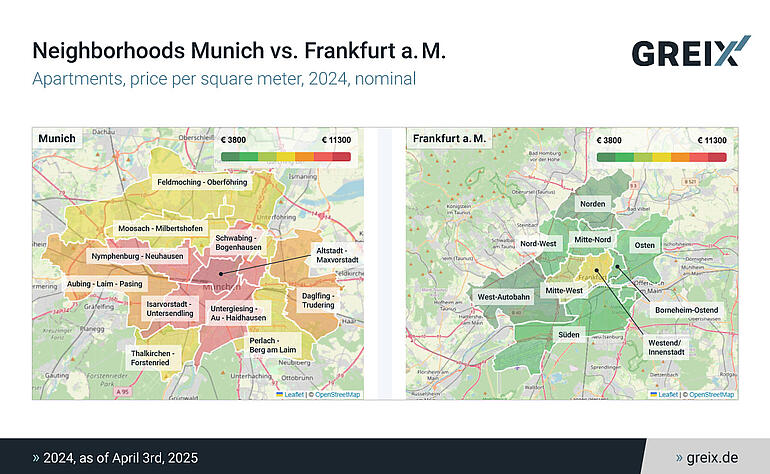Greix
House prices in city centers fall more sharply than in other neighborhoods
In the case of apartments, central and non-central locations are again converging in terms of price. The premium that buyers pay for apartments in central locations in major German cities has fallen.

Most recently, buyers paid a price premium of 1110 euros per square meter for apartments in city center locations. During the price upswing between 2012 and the first quarter of 2022, it was 1220 euros.
Prices have converged the most in Hamburg. In the city center, house prices have fallen by 17.8 percent since 2022, while in the outskirts they have fallen by 11.8 percent, about 6 percentage points less. This is followed by Düsseldorf, where prices in central locations have fallen by 17.5 percent, more than 5 percentage points more than in non-central areas at 12.4 percent.
"Real estate buyers are more hesitant about the price premium for prime city center locations," says Jonas Zdrzalek, real estate expert at the Kiel Institute for the World Economy, "this may have to do with changes in housing requirements and commuting in home office times."
Year-over-year: Rising prices, especially in less central locations
A year-over-year comparison of 2024 vs. 2023 shows correspondingly large differences in the price performance of apartments in the seven largest German cities (Berlin, Düsseldorf, Frankfurt am Main, Hamburg, Cologne, Munich, Stuttgart).
While house prices fell nationally, they rose in some districts, in some cases significantly, especially in the outer neighborhoods.
The strongest price increases were recorded in Düsseldorf Bilk-Oberbilk (+11.6%), Frankfurt Mitte-Nord (+8.9%) and Hamburg Harburg (+7.6%). The sharpest price declines were recorded in Hamburg Mitte (-16.5%) and Düsseldorf Altstadt-Stadtmitte (-10.4%).
Significant price differences between districts in Hamburg, Cologne, Berlin and Frankfurt
Although the price premium for central locations is falling, there is still a large difference between the most expensive, often central and cheapest neighborhoods in many German cities. With a premium of more than 80 percent, it was among the highest in Cologne (Innenstadt 5600€/m2 vs. Chorweiler 3000€/m2) and Frankfurt (Westend/Innenstadt 7100€/m2 vs. West-Autobahn 3800€/m2).

Prices were closest in Stuttgart (Mitte-Nord 5300 €/m2 vs. Neckar-Ost 3600 €/m2). However, the premium in 2024 was still almost 50 percent.
"The rise in interest rates since 2022 may have led buyers to look for riskier but higher-yielding properties outside the city centers," says Jonas Zdrzalek, real estate expert at the Kiel Institute for the World Economy, "in addition, fewer buyer groups may simply be able to afford expensive city center apartments due to inflation-related real wage losses."
Major cities: Cheapest neighborhoods in Cologne
In almost all 7 German metropolitan areas, there are neighborhoods where prices per square meter are lower than the GREIX average of the 20 cities and regions investigated - so buyers can find alternatives to expensive and very popular locations. The only exception: Munich.
Here, even in the cheapest neighborhood of Moosach-Milbertshofen, the price per square meter in 2024 was higher than in the most expensive neighborhood of any other major German city, at around 7500 euros per square meter. In Munich's most expensive neighborhood, Altstadt-Maxvorstadt, the price per square meter was around 11,300 euros.

Outside of Munich, the most expensive neighborhoods are in Hamburg, Frankfurt and Berlin at around €7,000/m2. The cheapest neighborhoods in Germany's major cities are in Cologne, with apartments in Chorweiler, Porz, and Kalk costing around €3,000/m2.
Read complete report now:
Methodological note
The Greix is a price index based on a hedonic regression method. This method mitigates price distortions that often arise when using average price per square meter. For instance, if a high number of large apartments in a prime location are sold in a given year, this can inflate average prices per square meter. However, such fluctuations may not reflect a general increase in real estate values. Using hedonic regression methods, specific property characteristics do not cause upward or downward distortions in the price trend.
About the Greix:

- What is the Greix?
The Greix is a real estate price index for Germany based on the sales price collection of the local expert committees, which contains notarized sales prices. It tracks the price development of individual cities and neighborhoods back to 1960 and is based on more than two million transaction data. The dataset can be used to analyze long-term trends in the real estate markets and to place current developments in a historical context. - What data and methods are used to create the indices?
The data collection and evaluation take place in cooperation with the local expert committees. All real estate transactions are recorded in full. The price development is calculated according to the latest scientific standards and statistical methods (hedonic regression method). The Greix thus stands for the highest scientific data quality. - Who is funding the Greix?
Greix is financed by public funding and is a project of the Bonn-Cologne Cluster of Excellence ECONtribute, which is funded by the DFG, and the Kiel Institute for the World Economy, in cooperation with the local expert committees. Its aim is to increase price transparency in the real estate market. Different price indices for 18 cities are freely accessible at www.greix.de. Additional cities will gradually be added to the data set.




